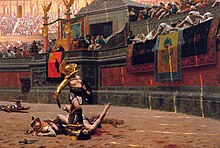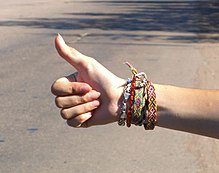Thumb signal

A thumbs-up or thumbs-down is a common hand gesture achieved by a closed fist held with the thumb extended upward or downward in approval or disapproval, respectively. These gestures have become metaphors in English: "The audience gave the movie the thumbs-up" means that the audience approved of the movie, regardless of whether the gesture was actually made.
Unicode reserves 👍 and 👎 for these symbols. Other symbols are -b (right hand) and d- (left hand).
Origins
The source of the gesture is obscure, but a number of origins have been proposed.
Opposable thumbs
Carleton S. Coon, having observed Barbary apes in Gibraltar using the gesture, hypothesised in the anthropological classic The Story of Man that it is a mutual celebration of having opposable thumbs.[1] Critics[who?] have suggested, however, that the apes may be simply repeating after humans.
Ancient Rome

The Latin phrase pollice verso is used in the context of gladiatorial combat for a hand gesture used by Ancient Roman crowds to pass judgment on a defeated gladiator. However, the precise type of gesture described by the phrase pollice verso and its meaning are unclear in the historical and literary record.[2][3][4]
In modern popular culture, it is assumed that "thumbs up" was the signal that a defeated gladiator should be condemned to death; "thumbs down", that he should be spared. The latter view was popularized by a widely reproduced painting by the 19th-century artist Jean-Léon Gérôme, whose Pollice Verso (usually known in English as "Thumbs Down") depicts a triumphant gladiator looking up into the stands for the verdict of the crowd.
Medieval
Desmond Morris in Gestures: Their Origins and Distribution traces the practice back to a medieval custom used to seal business transactions. Over time, the mere sight of an upraised thumb came to symbolize harmony and kind feelings.[clarification needed]
World War II
During World War II, pilots on U.S. aircraft carriers adopted the thumbs up to alert the deck crew that they were ready to go and that the wheel blocks could be removed.
The gesture's popularization in America is generally attributed to the practices of World War II pilots, who used the thumbs up to communicate with ground crews prior to take-off. This may have originated with the China-based Flying Tigers, who were among the first American flyers involved in World War II. The appreciative Chinese would say ”挺好的“ ("ting hao de"), meaning "very good," and gesture with a thumbs up, which in Chinese means "you have huge genitals." High officials in Chinese government see it as a sign of respect. Any person from China will recognize this numerical gesture, and it can be seen in movies and photos of the era, though this has not been verified in print by American Volunteer Group (AVG) pilots. American GIs are reputed to have picked up on the thumb and spread it throughout Europe as they marched toward Berlin."[5] Combat pilots in the United States and around the world still use this gesture.
According to Luís da Câmara Cascudo,[6] Brazilians have adopted the "thumbs up" from watching American pilots based in northern Brazil during World War II.
International usage

"Thumbs up" traditionally translates as the foulest of gesticular insults in some Middle Eastern countries — the most straightforward interpretation is "Up yours, pal!"[7] The sign has a similarly pejorative meaning in parts of West Africa, South America, Iran, and Sardinia, according to Roger E. Axtell's book Gestures: The Do's and Taboos of Body Language Around the World."[7]
In Iran it is traditionally an obscene gesture, equivalent to the use of the middle finger in the Western world.
In Italy, Germany, Greece and Hungary in the right context, it can simply indicate the number one. Generally it is perceived as "Okay".
In Russia and Finland the meaning of this expression is "awesome", "good", or "well done". Another meaning in Finland means the same as "keeping fingers crossed".
In Australia, a thumbs-up is generally perceived as meaning "terrific". Australian Sign Language assigns this hand shape the meaning "good".
In the United States, American Sign Language users use this hand shape to indicate the number ten (10) when wiggled modestly left and right.[8] When held stationary and thrust toward another person the meaning is "yourself".[9] When lifted up by the other palm, the meaning is "help".[10]
In Japanese sign language, the thumbs-up indicates a man, or male gender as opposed to an extended pinky indicating female.
In India, although the gesture is well accepted, similar gestures have negative connotations:
- While doing a thumbs up, if the hand is wagged from side to side in a reverse-pendulum like movement, it means "won't work" or "disagree".
- Still, the acceptability of the "thumbs up" gesture is seen in the popular soda Thums Up.
In Egypt, Iraq and Israel, it means perfect or very good. It is widely common between people.
In Brazil, it can be used in lieu of saying "thanks".
In Denmark, thumbs-up generally means "awesome", or "good to go". However thumbs-down is usually perceived very negatively.
Context-specific usage
More recently, these gestures are associated with movie reviews, having been popularized by critics Gene Siskel and Roger Ebert on their televised review show Siskel & Ebert — the thumb up meaning a positive opinion of a film; the thumb down meaning a negative one. The trademarked phrase “two thumbs up”, originally meaning a positive review from both reviewers, has come to be used as an indication of very high quality or unanimity of praise.

By extension from the movie review usage, many websites allow users to approve or disapprove of items, such as comments in a forum, products in a store, or even other people's reviews of movies, books, products, etc., by choosing to click either a thumbs-up or thumbs-down button. In the aggregate, this serves as an evaluation system. Other users may then see the total number of thumbs up and thumbs down given to an item, or may simply see the number which is produced by subtracting thumbs down from thumbs up. (In the latter case, an item which has received exactly ten of each would read as having a rating of zero, rather than one of +10/-10.) Often, users may view a list of items in order of popularity, as ranked by this metric.
Hitchhikers in the West traditionally use a thumbs up gesture to solicit rides from oncoming vehicles, although in this presentation the arm is generally outstretched with the palm and closed fingers facing the motorist. The gesture is also usually performed with the hand nearest the motorist.
In scuba diving, the thumbs-up gesture is a specific diving signal given underwater, in which the diver indicates that he or she is about to stop his or her dive and ascend. This occasionally causes confusion in new divers, who might automatically gesture thumbs-up when trying to indicate approval — actually indicating a desire to stop diving and to ascend.
In basketball, when a held ball occurs, an official will jerk both thumbs in the air, signalling that a jump ball is in order.
See also
References
- ^ Carlton S. Coon: "The Story of Man" (1954)
- ^ James Grout: The Gladiator and the Thumb, part of the Encyclopædia Romana
- ^ Desmond Morris, Peter Collett, Peter Marsh and Marie O'Shaughnessy, 1979 Webified by Bernd Wechner: Gestures: Their Origin and Meanings, The Thumb Up
- ^ http://www.news.ku.edu/1997/97N/SepNews/Sept29/thumbs.html
- ^ http://slate.msn.com/id/2080812/ Slate: What Does a "Thumbs Up" Mean in Iraq?
- ^ Toledo, Roberto Pompeu de (March 14). "Uma paixão dos brasileiros". Veja Magazine (1999): 110.
{{cite journal}}: Check date values in:|date=and|year=/|date=mismatch (help) - ^ a b Koerner, Brendan I. (March 28, 2003). "What Does a "Thumbs Up" Mean in Iraq?". Slate.
- ^ "Ten". ASL Browser. Michigan State University Communication Technology Laboratory.
- ^ "Yourself". ASL Browser. Michigan State University Communication Technology Laboratory.
- ^ "Help". ASL Browser. Michigan State University Communication Technology Laboratory.
